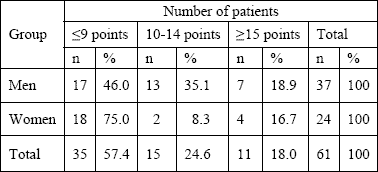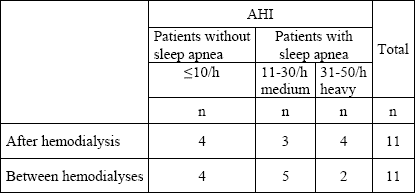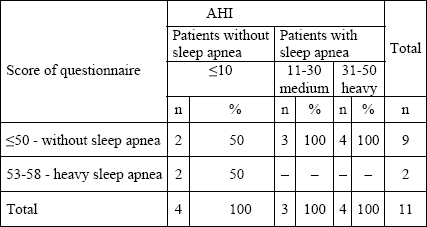The study was performed in accordance with the Declaration of Helsinki for human studies and the study protocol was approved by a local Ethics Committee. Sixty-one ESRD patients participated in the study: 24 women (mean age 57.2 ±10.8(SD) yr; duration of hemodialysis 91.0 ±48.6 mo) and 37 men (mean age 58.5 ±13.2 yr; duration of hemodialysis 62.2 ±57.4 mo).
The study consisted of three parts. All patients participated in the first part of the study: a questionnaire-based survey and Epworth Sleepiness Scale (ESS). The patients were asked about loud and irregular snoring, reported incidents of apnea, and daytime sleepiness. The second and third parts consisted of nighttime PSG (Alice3 Polysomnograph, Respironics, Murrysville, PA) performed the night after hemodialysis (17 patients) and between hemodialyses (11 patients). For the PSG recording patients went to bed at their usual time and woke up spontaneously. Six out of the 17 patients from the second part of the study could not complete the following PSG and thus dropped out from the third part. Chi2 test and Fisher’s test were used for data analysis.
The analysis of questionnaires indicated that of the 61 patients, there were 50 without symptoms of sleep apnea (29 men, 21 women), 6 with medium (4 men, 2 women), and 5 with heavy sleep apnea symptoms (1 woman, 4 men) (Table 1). Lack of daytime sleepiness was reported by 35 patients (18 women, 17 men), 15 patients reported medium (2 woman, 13 men), and 11 patients reported heavy daytime sleepiness (4 women, 7 men) (Table 2).
| Table 1.
Results of questionnaire analysis: |
 |
| Table 2.
Number of patients as per the score on the Epworth Sleepiness Scale: |
 |
Eleven subjects were involved in the double polysomnographic study: after and between hemodialyses. Based on the number of apneas and hypopneas per hour of sleep (apnea/hypopnea index - AHI) during the night just after hemodialysis we found:
- 4 patients without sleep apnea (AHI
- 3 patients with medium sleep apnea (AHI 11-30/h),
- 4 patients with heavy sleep apnea (AHI 31-50/h).
The second nighttime polysomnography performed between hemodialyses showed:
- 4 patients without sleep apnea (AHI
- 5 patients with medium sleep apnea (AHI 11-30/h),
- 2 patients with heavy sleep apnea (AHI 31-50/h).
Thus, sleep apnea was found in 7 patients in each of the two polysomnographic nights analyzed (Table 3). In all subjects mixed apneas (central and obstructive) were observed.
| Table 3. Apnea-hypopnea index (AHI) in patients just after hemodialysis and between hemodialyses. |
 |
| n, number of patients |
The results of questionnaires showed that only 2 patients of the 11 who participated in all three parts of the study had the characteristics of obstructive sleep apnea (53-58 points) (Table 4). There was no significant correlation between the questionnaire and AHI scores.
| Table 4. Questionnaire score and apnea-hypopnea index (AHI). |
 |
| n, number of patients. There was no correlation between the AHI and questionnaire scores. |
In the questionnaires, 18% of ERSD patients reported snoring, daytime somnolence, nocturnal apneas events, restless sleep, and headaches. These results are in agreement with other data suggesting that the prevalence of sleep disturbances in patients undergoing chronic dialysis treatment may be at least five times as high as that in the general population (3-8). Our results of the clinical polysomnographic investigation did not correlate with the questionnaire score. However, the prevalence of obstructive sleep apnea found during the double polysomnographic examination (the second and third parts of the current study) was even higher, 7 out of the 11 patients showed pathologically increased AHI. Although these results do not explain the high rate of sleep disorders in the ERSD patient population, they support the opinion that the diagnosis of sleep apnea is of potential significance for the assessment of cardiovascular risk factors in dialyzed patients. Subjective complaints of ERSD patients, typical for sleep apnea, are often overlooked, being mistakenly attributed to the chronic renal failure (3). Thus, the divergence between polysomnographic and questionnaire results is explicable by the complexity of the clinical issue.
Our results confirm the previously reported observation (9) that the procedure of hemodialysis does not change the prevalence of sleep apnea in patients with chronic renal disease. Therefore, the issue why breathing disorders during sleep are eliminated after successful renal transplantation (8, 10) still continues to pose a challenge.
Acknowlegdments: This study was supported by KBN grants 2P05D07226, 2P05B02626, and the statutory activity of the Department of Hygiene, the Department of Epidemiology, and the Department of Physiology of Bydgoszcz Collegium Medicum of the Nicolaus Copernicus University in Torun.
- Benz RL, Pressman MR, Hivick ET et al. A preliminary study of the effects of correction of anemia with recombinant human erythroprotein therapy on sleep, sleep disorders, and daytime sleepiness in hemodialysis patients (The SLEEPO study). Am J Kidney Dis 1999; 34: 1089-1095.
- Benz RL, Pressman MR, Hivick ET et al. Potential novel periodictors of mortality in end-stage renal disease patients with sleep disorders. Am J Kidney Dis 2000; 35: 1052-1060.
- Zoccali C. Sleep apnea and nocturnal hypoxemia in dialysis patient: mere risk- indicators or causal factors for cardiovascular disease. Nephrol Dial Transplant 2000; 15: 1919-1921.
- Pressman MP, Benz RL, Schleifer CR, Peterson DD. Sleep disordered breathing in ESRD: acute beneficial effects of treatment with nasal continuous positive airway pressure. Kidney Int 1993; 43: 1134-1139.
- Kimmel PL, Miller G, Mendelson WB. Sleep apnea syndrome in chronic renal disease. Am J Med 1989; 86: 308-314.
- Fletcher EC. Obstructive sleep apnea and the kidney. J Am Soc Nephrol 1993; 4: 1111-1121.
- Kimmel P. Sleep apnea in end-stage renal disease. Semin Dial 1991; 4:52-58.
- Langevin B, Fouque D, Leger P, Robert D. Sleep apnea and end-stage renal disease: Cure after renal transplantation. Chest 1993; 103: 1330-1335.
- Mendelson WB, Wadhwa NK, Greenberg HE et al. Effects of hemodialysis of sleep apnea syndrome in end-stage renal disease. Clin Nephrol 1990; 33: 262-266.
- Yasuda T, Nishimura A, Katsuki Y, Tusji Y. Restless legs syndrome treated successfully by kidney transplantation: A case report. Clin Transplant 1986; 138.